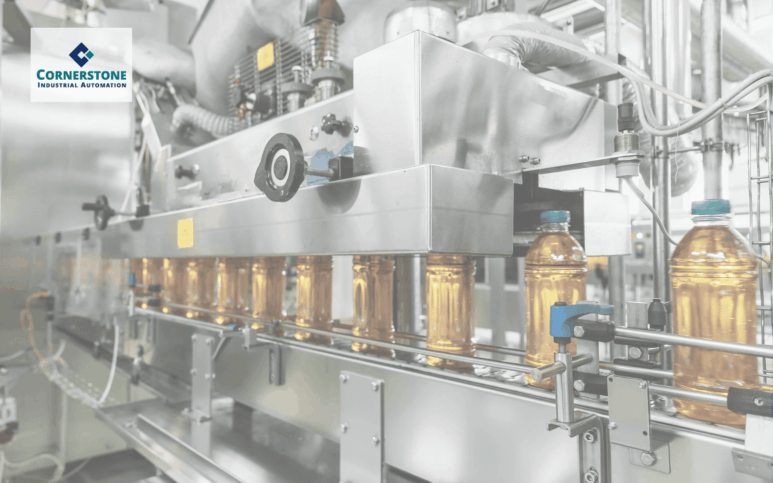Originally published in Automation World magazine, this article shares practical insights from the plant floor. It draws on decades of hands-on experience to help manufacturers tackle documentation gaps, harsh environments, and obsolescence risks head-on.
System Integrators (SIs) ensure that manufacturing plants operate smoothly and efficiently. Drawing from extensive experience on the ground, Cornerstone Automation has identified three primary challenges that frequently arise in automated plants: lack of program documentation and drawings, insufficient knowledge of plant environments, and the disconnect between obsolescence and unplanned downtime. Addressing these issues is vital for optimizing the use of automation technologies.
The Documentation Dilemma
Lack of Program Documentation and Drawings
One significant issue in automated plants is the absence of essential program documentation and drawings. These are crucial for repairs and modifications. According to industry professionals, many owners, managers, and even maintenance personnel often undervalue electrical and mechanical schematics.
“The lack of documentation can severely extend downtime during repairs,” explains industry veteran, Alan Ferrin. “Without proper documentation, we’re often forced to reverse-engineer solutions, which is time-consuming and costly.”
In many cases, the absence of documentation leads to a thorough process of manually tracing wires and drawing out system schematics. This scenario is especially challenging when dealing with long wire runs and complex systems. For example, equipment purchased from the used market often lacks proper documentation, creating hidden costs for future maintenance.
Mitigating Documentation Issues
To address these challenges, it is recommended to maintain a comprehensive inventory of all documentation and ensure it is consolidated and protected. Modern solutions include storing documentation in PDF form within human-machine interfaces (HMIs) and embedding descriptive documentation directly into programmable logic controllers (PLCs).
These solutions are not failproof and still require diligent backup practices. “If you lose the program and don’t have it stored elsewhere, you’re facing significant downtime,” Alan stated. Proper documentation storage and regular backups are essential business practices.
SI Tip: Establish a rigorous documentation protocol. Ensure every automation project includes detailed schematics, wiring diagrams, and program documentation. Regularly update these documents to reflect any changes or upgrades. Utilize digital documentation tools that allow easy access and updates, ensuring the most current information is always available.
Understanding the Plant Environment
Impact of Environmental Factors
Plant personnel may lack a thorough understanding of their operational environment, which includes factors such as temperature, humidity, moisture, particulates, and corrosive chemicals. This knowledge gap can lead to improper equipment selection, installation issues, and accelerated wear and tear on automation systems.
“Heat is the biggest enemy of electronics,” Alan Ferrin emphasizes. “Some professionals think that for every 10 degrees above room temperature, the lifespan of industrial electronics is cut in half.”
Dust, water, and corrosive chemicals also pose significant threats. Lack of dust control is frequently caused by design flaws, while water ingress, especially in wash-down environments like meat packing or bakeries, can be disastrous for electronics.
Best Practices for Environmental Management
To mitigate these risks, plant owners and engineers must ensure proper enclosure and cooling practices. Stainless steel enclosures, for instance, require careful consideration due to their poor heat dissipation properties. Another factor to consider is that modern enclosures must be resistant to the caustic cleaning solutions used in many hygienic environments.
“Using proper gaskets and sealants and avoiding top penetrations in enclosures are essential practices,” Alan advises. “Conformal coatings on circuit boards, offered by leading PLC manufacturers, can also provide additional protection against corrosive environments.”
SI Tip: Conduct a comprehensive environmental assessment before selecting and installing automation technologies. Use sensors and monitoring tools to gather real-time data on environmental conditions. Train plant personnel on the importance of these environmental factors and how they impact automation systems. Regularly review environmental data to anticipate and mitigate potential issues.
Connecting Obsolescence with Unplanned Downtime
Outdated Technology and its Implications
The third major issue is the reliance on outdated technology. Many plant managers fail to recognize the link between obsolete equipment and unplanned downtime. As components age, their reliability decreases, leading to unexpected failures that can halt production. Proactive management of obsolescence is essential to maintaining continuous operations.
“Many clients are still using DOS-era technology on the plant floor, while their office equipment has long since been updated,” Alan points out. This disconnect can result in frequent breakdowns and a lack of compatibility with modern systems.
Adopting Advanced Solutions
Modernizing plant technology is not just about updating equipment but also about adopting proactive maintenance practices. Advanced PLCs and HMIs offer improved functionality, better integration with existing systems, and enhanced durability under harsh conditions.
“It’s crucial to communicate the benefits of modern technology to higher-level management,” Alan concludes. “While initial costs may be high, the long-term benefits of reduced downtime and increased efficiency are substantial.”
SI Tip: Implement a proactive obsolescence management plan. Regularly review the lifecycle status of all automation components and create a schedule for their replacement or upgrade. Utilize predictive maintenance tools that forecast equipment failures based on usage and wear patterns. Educate plant management on the costs of unplanned downtime versus the benefits of planned upgrades.
Addressing the common challenges in automated plants requires a comprehensive approach. Ensuring proper documentation, understanding and mitigating environmental factors, and embracing modern technology are essential to enhance operational efficiency and reduce downtime. By adopting these practices, plants can achieve greater reliability and productivity, ensuring smoother operations and better outcomes. System Integrators are an instrumental resource in guiding plant personnel through these processes ensuring that automation technologies deliver maximum value and reliability.
For further insights and detailed guidance on industrial automation technologies, reach out to your trusted system integrator.
